Your browser is out-of-date!
Update your browser to view this website correctly. Update my browser now
Home › Reviews › Mobilvetta › K-Yacht Tekno Line

Mobilvetta Tekno Line K Yacht 95 2022
By Peter Baber Published: June 21, 2022
The rear-lounge layout of this comfortable and spacious four-berth should appeal to UK buyers, says Peter Baber
We’ve recently reviewed the K Yacht 59, Mobilvetta’s A-class take on an increasingly popular end-washroom layout.
But that is not the only new A-class model the Italian manufacturer – whose vehicles are brought to the UK exclusively by Marquis Leisure – has launched for the 2022 season. Ever mindful of the UK market, the Trigano Group brand has also launched the rear-lounge K Yacht 95.
This 7.45m-long vehicle has many of the same external upgrades as its sibling – a bigger windscreen, 4400kg MTPLM (which gives you a 1002kg payload, easily enough for four), Alde heating and Fiat’s nine-speed automatic gearbox.
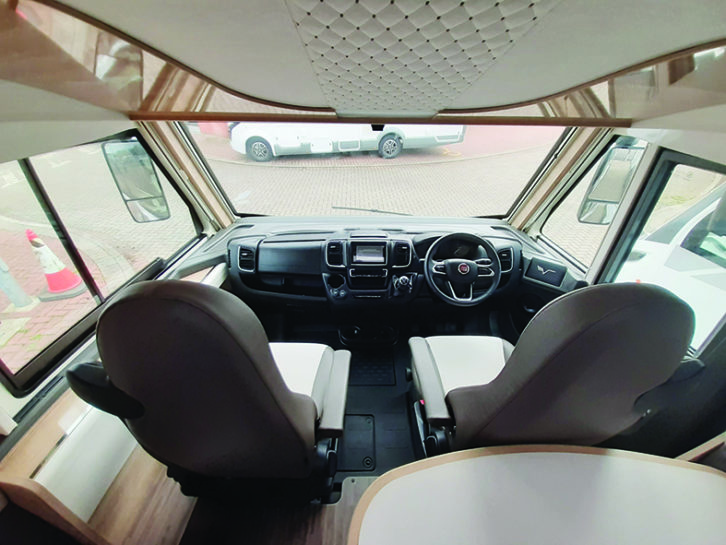
In addition, you still get the driver’s door on the ‘right’ side for the UK, and a rear-view camera. The main difference is the garage that runs right across the motorhome under the rear lounge.
Inside, the front dinette includes a large permanent table, easily big enough for four.

While the windows let in plenty of daylight, an LED under the drop-down bed lights the area at night. There are TV sockets and a bracket above the travel seats , and so long as you are not sitting in those seats, TV viewing should be fine.
A cloth pocket on the edge of the settee closest to the door is a handy place to keep your magazines. There is a mains socket on the other edge of this settee, and two USBs on the forward edge of the offside settee.
The rear lounge is spacious, but the base cushions rest on boards, rather than slats, which these days feels a touch old-fashioned.
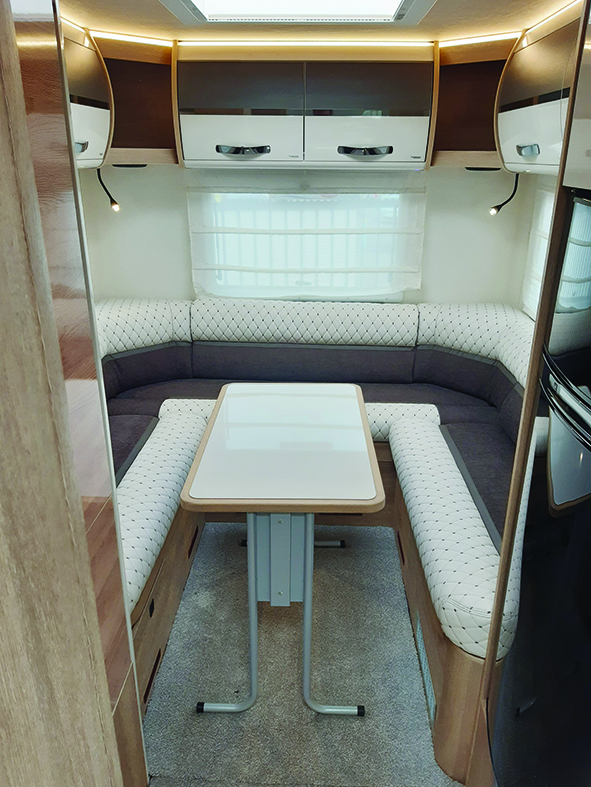
The foldaway table here is plenty bit enough, although getting it out of the wardrobe was quite a challenge.
The side kitchen has a useful ambient light at worktop level – great at night and a helpful addition to the daylight coming through the large window.

Work space is a little minimal, but usefully the three-burner hob does include an induction plate. You also get a handy spice rack, and a socket above the hob for a kettle. There is a 149-litre fridge with an ample freezer – easily enough for the provisions of a family of four, although it is only three-way, not AES. Pleasingly for a Continental-built motorhome, you do get a combined oven and grill here.
Despite being a side washroom, the shower cubicle gets its own roof vent. It also has two drain holes – handy if the ‘van is not quite level when you’re pitched up – and a shelf for toiletries.
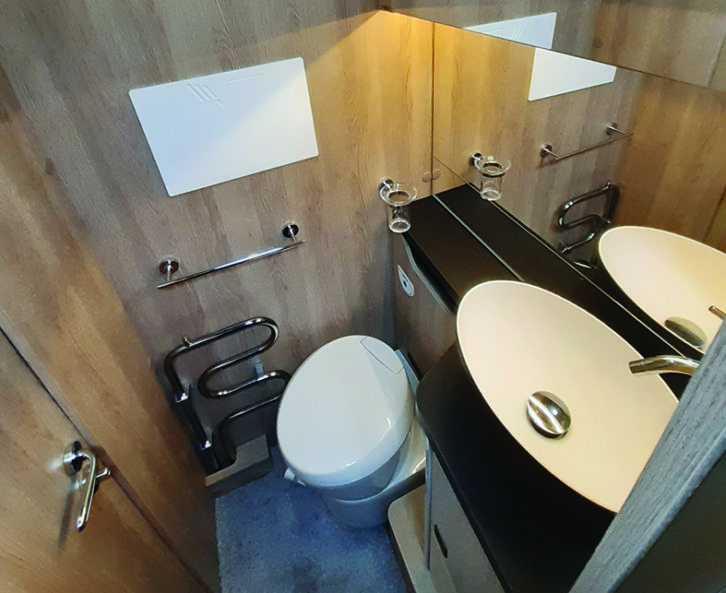
The main washroom has a salad-bowl style handbasin, ladder radiator, mirror, toothbrush mug and toilet roll holder. The offside location means the cassette toilet hatch is away from any awning.
The drop-down bed is easy to manage and a good width at 1.3m. It includes a well-placed light for reading.
The two settees in the rear lounge are 1.94m long, so they make comfortable single beds on their own by removing the backrests. But you can almost as easily make up the double by pulling out slats. The cushions fit snugly.
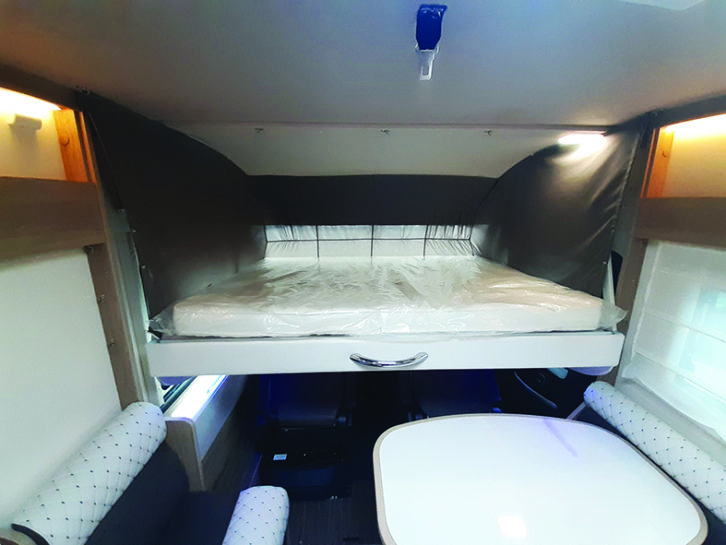
In terms of storage: there is internal access to the area under the offside settee. There is to the nearside settee too, although much of this is taken up with the Alde heater. There is no internal access to the rear gage. There are six overhead lockers, and a wardrobe, too; the latter is half-height, and there’s a small cupboard below it.
In the front lounge there is storage under the nearside seat, one overhead locker and cubby-holes in the cab
The kitchen has two further lockers, two useful pan cupboards and two drawers.
The washroom has a large cupboard and a shallower one behind the mirror. You can open these without having to open the main washroom door.
PRACTICAL MOTORHOME SAYS…
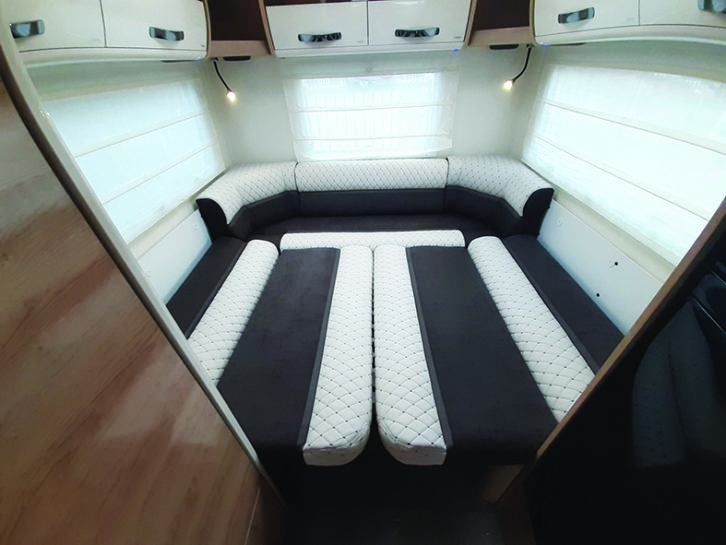
This A-class model certainly looks and feels luxurious – it’s stylish and everything feels good quality. For the price, we’d like to have seen a microwave and separate oven, but storage is good, allowing you to make the most of that large payload.
The K Yacht 95 certainly makes Mobilvetta’s line-up even more amenable to the UK buyer than it already was. Its rear lounge is very comfortable, and will provide more than adequate sleeping for growing children right up until they are teenagers.
If you liked this… READ THESE:
Review: Mobilvetta Tekno Line K Yacht 59
Review: Carthago Chic C-Line I 4.9 Le L Superior
Best A-class motorhome for 2022
If you’ve enjoyed reading this article, why not get the latest news, reviews and features delivered direct to your door or inbox every month. T ake advantage of our brilliant Practical Motorhome magazine SUBSCRIBERS’ OFFER and SIGN UP TO OUR NEWSLETTER for regular weekly updates on all things motorhome related.
Its rear lounge is very comfortable, and will provide more than adequate sleeping for growing children right up until they are teenagers
Technical Specifications
| Berth | 4 |
| MiRO | 3398 kg |
| Payload | 1002 kg |
| MTPLM | 4400 kg |
| Shipping Length | 7.45 m |
| Width | 2.74 m |
| Engine Size | 2300 cc |
Related Reviews
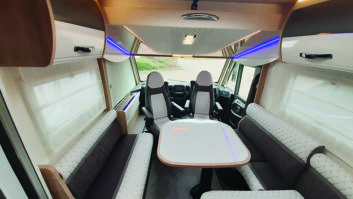
Mobilvetta Tekno Line K Yacht 59 2022
This compact, couples-friendly motorhome benefits from some impressive touches, at a price that's right
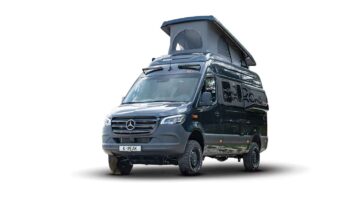
Yucon K Peak 7.0 GD 2024
The Yucon K Peak 7.0 GD is a capacious ‘microliner’ and will appeal to those who...

Malibu Genius 641 LE 2025
The Malibu Genius 641 LE is an innovative campervan where the extra length makes all the...

Bilbo’s Celex HL 2024
Bilbo's Celex HL is a clever conversion with a practical layout, good looks and lots of...

Benimar Mileo 294 2024
The cleverly designed washroom in the Benimar Mileo 294 is just one of the 'van's many...


Auto-Sleeper Burford Duo 2024
The Auto-Sleeper Burford Duo is a comfortable, solidly built low-profile which should suit two on tour,...

Bailey Alora 69-4S 2024
The Bailey Alora 69-4S is a four-berth with a clever layout that is designed to provide...

Bailey Alora 69-4T 2024
Thoughtful design gives the Bailey Alora 69-4T, a compact three-berth, a distinctly Continental style, says Peter...
On Test - Mobilvetta Tekno Line K-Yacht 59
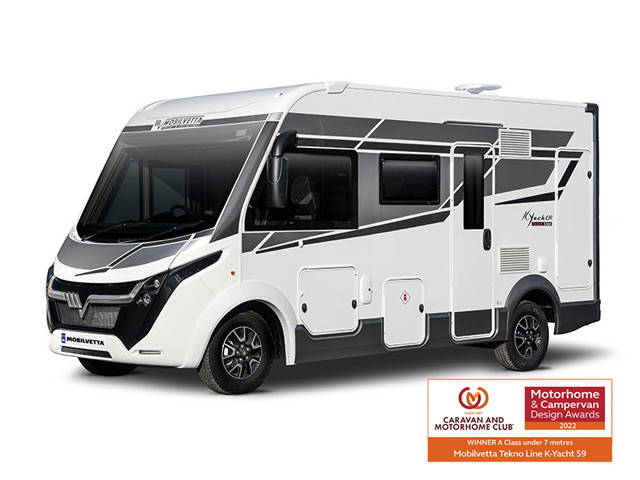
New for 2022, the all new & award-winning Mobilvetta Tekno Line K.Yacht 59 model boasts 3 berths and 4 travelling seats, rear bathroom and all within a compact A Class length of just 5.99m. With ample storage inside & out, this is the perfect luxury touring vehicle.
Read the latest on test review from The Caravan & Camping Club below.
After driving over the borders of Wales and England, Huw Hopkins from the Camping & Caravanning Club, puts this compact motorhome to a live-in test in Warwickshire for his latest review...
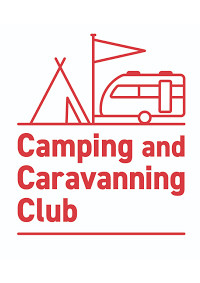
Mobilvetta Stock Available to buy
Check out our Mobilvetta Motorhomes available now for immediate delivery & due in to reserve.

The Batsbi?
Other peoples, resources & links, the pagan religious practices of the chechens and the ingush.
The following article on the pagan religious beliefs and practices of the Chechens and the Ingush was copied from the December 2010 edition (Vol. 8, No.3) of Interreligious Insight ( link ) — "a journal of dialogue and engagement" published by the World Congress of Faiths. The article was written by Dr. Michael Berman, a teacher and writer whose publications include The Shamanic Themes in Armenian Folktales , Shamanic Journeys through the Caucasus , Georgia through its Folktales and Shamanic Journeys Through Daghestan (please see my short Caucasian bibliography for full bibliographical information). "Michael originally trained as a Core Shamanic Counsellor with the Scandinavian Centre for Shamanic Studies, but these days his focus is more on the academic side of shamanism, with a particular interest in the folktales with shamanic themes told by and collected from the peoples of the Caucasus. For more information: www.Thestoryteller.org.uk". Dr. Berman's article is of great interest, for it contains many quotations from Bashir Dalgat's remarkable "Pervobytnaia religiia chechentsev" ("The aboriginal religion of the Chechens"), first published (in abriged form) in 1893 in Vladikavkaz in Terskii Sbornik , the journal of the "Terskii Oblastnoi Statisticheskii Komitet" ("Terek oblast Statistical Committee"). Dalgat's book is one of the earliest sources of information on the traditional i.e. pagan religious beliefs and customs of the Nakh peoples, and is a highly-valued "primary" source of information for any student of such matters.
Before considering the religious practices of the Chechens and Ingush, it might be best to start with some background information on the region. The Chechens live in a small territory called Chechnya bordered by Daghestan to the east and northeast; Ingushetia and north Ossetia to the west; Russia‘s Stravrapol Province and Cossack region to the north; and Georgia to the south and southwest. The Caucasus Mountains, which stretch along a line 1,100 kilometres long between the Black Sea and Caspian Sea, protect the people not only from enemies but from outside influences in general. The Chechens therefore have retained many traditional customs and practices. As for Ingushetia, it was created in June 1992 as a result of the secession of the Ingush from Checheno-Ingushetia, where the Ingush had been very much in the minority. The decision to break away followed the declaration of independence by the Chechens in 1991 (see Matveena, 1999, pp. 91 & 92). The Chechens and Ingush have lived where they are now since prehistoric times, and while the Mesopotamians, Persians, Turks, Mongols, Slavs and others have greatly influenced the region with their wars, conquests and trade, being fiercely proud and protective of their roots and background, the inhabitants of Chechnya have remained ethnically the same for thousands of years. As for the languages spoken by the peoples, both Chechen and Ingush belong to the nakh branch of the nakh- Daghestanian, or northeast Caucasian, language family and they can both understand each other. Although the current generation of Chechens and Ingush are Muslims and what they practise is a localized Sufi tradition, they still preserve remnants of their pagan past in both their traditions and their folktales. Like many other tribal peoples, the Ingush and the Chechens believed in existence beyond the grave and this was reflected in their burial practices: The belief was based on the evidence of eye-witnesses, of people who have visited the other world – very typical of many other peoples of the world. The other world is similar to this one; it is constructed with the imagination of the Ingush and Chechens by analogy with their native land, the mountain region... The other world is under the ground. It is ruled by the underground God, Eshtr or Eter. A man dies only when that God wishes to take him. The other world is called in Ingush Deli-Ailli, while this present world is Deli-Malkhli. The Ingush say, Deli-Malkhli was built in three years, Deli-Ailli was built in seven years. (Dalgat, 2004, p. 25) This, no doubt, partly explains why the numbers three and seven feature so prominently in the folktales from the region. (The fact that traditionally an Ingush or Chechen man is expected to know the names and birthplaces or origins of his paternal ancestors going back seven generations is yet another indication of the importance attached to this number). These peoples did not view death as going to one’s eternal rest, since the deceased in the other world were believed to do “all their work just exactly as in this world, and moreover simultaneously with the latter: when haymaking or harvesting finishes in this world, the work ceases simultaneously in the other world. The only difference is that the dead people work at nights, when the sun leaves the world of the living for the land of the dead” (Dalgat, 2004, p. 26). According to folk belief, at the moment of death, on the boundary between this world and the other one, when the divine Eshtr has already taken half of a man’s soul for himself, the dying man sees the other world with all those who have died before him. Those around him... pose him questions like: “How is such and such a dead person living?”... If the deceased had not been buried in the proper manner... [in a burial vault that was regarded as the necessary dwelling for a dead person], then the dying man would usually reply that the dead man was troubled without a roof. If a memorial feast had not been made for the deceased, then the dying man would say that the deceased had no food and was living on charity. The dying man would be given various errands to perform in the other world too. (Dalgat, 2004, p. 27) As for the burial of a dead person, he was buried along with everything it was thought he might need on the road to, and in, the other world. And at one time in the distant past, this would have included both his horse and his wife (see Dalgat, 2004, p. 32). The Chechen and Ingush concepts of the soul had much in common with those of other tribal peoples, as we can see from the following tale. One day lame Temir, whose son had been lost, called into a smithy. At that time the blacksmith was sleeping, and Temir, not wanting to interrupt his sleep, sat down next to him and began waiting for him to wake up. He noticed that a fly came out of the blacksmith’s nose, crawled along the tongs across a basin to the anvil. Beyond the anvil there was a huge fissure; the fly descended into this fissure and stopped there quite a long time. Then it crawled back out and, after passing the anvil, crossed the basin by the same tongs, but while crossing it fell into the water. For a long time it was struggling in the water, with difficulty it crawled out on to the tongs, and went back into the nose of the blacksmith. “It seems I have been asleep for a long time!” “Yes, and I was sitting here all the time you were asleep”. Temir replied. Temir said to the blacksmith, “Amuse me. I have lost my son, and I am in great grief. Tell me something”. “But what can I tell you. After all, we cannot reach what I have just seen in my dream”. Temir started asking him to relate his dream. The blacksmith began, “In my dream I crossed a big river and an iron mountain and went down into a large cave, where there was treasure of gold and silver; for a long time I stood there, not having the strength to tear my eyes away from the brilliance and the splendour. But being conscious that I had to return, I climbed out of the cave. On the return journey when I was crossing the river, I fell off the bridge and almost drowned”. Temir realised that the soul of the blacksmith had come out in the form of a fly. And guessing that there had to be a treasure in the smithy, he persuaded the blacksmith to give the place up to him. Then after digging up the place where the soul of the blacksmith had crawled, Temir exposed untold wealth, with which he collected an army and subjugated the whole world. (Dalgat, 2004, p. 39-40) This traditional folktale illustrates the ancient Ingush belief in the reality of dreams and that the soul for them was something material rather than an abstract spiritual concept. In fact, it demonstrates an understanding of the soul that is remarkably similar to that of the Siberian Buryats. There is a parallel Buryat tale in which the soul takes the form of a bee when it crawls out of someone’s nose for an out-of-body experience (see Dalgat, 2004, p. 40). What the people practised can be described as a form of polytheism. Among the Chechens there were two systems of gods – a cult of ancestors and folk heroes and the worship of the deified powers of nature. The High or Supreme God, the King of all creation and the Father of all other gods is called Dela, Dyala or Deyla... The relation of Dyala to the other gods is like that of a father to his children: everything of course depends on Dyala; what He wants, that has to happen; but the other gods also act independently, each in his own sphere. (Dalgat, 2004, p. 98) The Chechens also had great respect for the one-eyed god Elta, the patron of hunters, who rules over the forests and the wild animals. He is the king of the forests and of all its inhabitants, both the forest people and the beasts. Success in hunting completely depends on Elta... In translation Elta means corn (breaded grain), and actually he performs two functions in parallel – the god of hunting and the god of the harvests. (Dalgat, 2004, p. 91) The Sun and the Moon are also anthropomorphised in Chechen folklore. The Sun and the Moon have mothers; the mother of the Sun, or Malkh-Nana, is called Azoy, and the mother of the Moon, or Betti-Nana, is called Kinch. The Chechens say that the Sun comes out of the sea in the morning, and sinks into it once more in the evening; when it comes up on to the horizon, something black separates from it; the people say that it is the sea pouring off the Sun. (Dalgat, 2004, p. 92) The Mother of the Winds was important as well. At the god’s command she would raise a terrible storm to blow away the goods of the dead who had sinned before God. For mediation between the gods and people the Chechens developed a special type of priest or shaman known as a tsaynsag. In order to become a tsaynsag , besides intelligence and good conduct and the respect of the population, the man also required the ability to interpret his dreams and to tell fortunes – qualities required from the Roman augurs, Siberian shamans and Indian priests. These qualities make the priest a real mediator between God and the people... The priest learns the cause of bad fortune and the will of the gods by means of divination, and several methods of divination exist among the Chechens... In former times there were very many sorcerers and sorceresses throughout Chechnya; everybody treated them with respect and resorted to their mediation in every difficult situation such as illnesses or general misfortunes, asking them to find out the cause of the misfortune and advise them how to be saved from it. “They were the mentors of the people and, like the gods, faithfully gave interpretation of dreams and explained illnesses”, said Ganzyh; they were called dzyry. (Dalgat, 2004, pp. 84, 85) Various forms of divination were practised, including the measuring of a shawl with the elbow, winding cotton wool round a spoon, making use of stones, mirrors, sheep’s bones and also by consulting Arab books (see Dalgat, 2004, p. 86). Of all the Chechens’ gods, the most mighty and honoured was Seli the Thunderer. In the Caucasus Mountains, the land of thunderstorms, this god found suitable soil for himself. In the mountains the most terrible phenomenon is the thunderstorm with thunder and lightning from them the Chechen has to suffer many problems of all kinds; every minute both his field and his very life suffer dangers from them. It is not surprising that Seli is held in such honour by the Chechens. He is the most terrible and most capricious god for them, and he has to be propitiated more then the others. But at the same time he is just, and punishes only those who deserve it... All the Chechens honour him equally, and one could say that even all of the inhabitants of the Caucasus Mountains (of course under various names) he is a god, not of one community or tribe, but of them all … One can judge the strength of the cult of Seli by the fact that they consider a man killed by lightning (Seli’s firebrand) as blessed, and he is buried quite separately from other dead people” (Dalgat, 2004, pp. 94, 95). A sacred place for the Chechens was the domestic hearth, believed to be chosen by God himself and so inviolable. A terrible retribution follows any insult or disrespect towards it. The fire, the chain, the cauldron and hearth enjoy the highest respect in the home: the chain and the cauldron are respected as symbols of the domestic hearth, while the fire [whose deity is known as Seli] is an indissoluble component of it. Even the ashes, and soot on the ceiling, are considered sacred, thanks to its connection with the hearth. (Dalgat, 2004, p. 53) Apart from the fact that it was considered to be sacred, the family hearth, in concentrating the members of the family round itself, also had an “organising” importance: Its cult sanctifies the power of the head of the family, as a devotee who brings sacrifices to the gods. Its influence [helps to explain] …the sacred character of the family as a community..., and the sanctity and inviolability of a guest as a temporary member of the family. (Dalgat, 2004, p. 55) And anyone who visits Chechnya will have the opportunity to experience firsthand the people’s legendary hospitality. In view of the fact that the peoples clearly believed in the existence of at least one other reality, that it was possible for adepts to undertake soul journeys, and in the efficacy of divination, to regard what was practised by the priests as a form of shamanism would surely be a reasonable assumption to make, even though the term itself would of course have been totally alien to them. As to whether the priests actually entered trance states in the course of their work, though, remains unclear. However, given the popularity of the mystic dance among followers of the Sufi tariqat or religious path, it would seem that people in the region have a natural propensity for doing so, which would suggest that even though we lack concrete evidence, it was very likely to have been the case. BIBLIOGRAPHY Dalgat, B. K. (2004) The Aboriginal Religions of the Chechens and Ingush , Moscow: nAUKA. (Translated from the Russian by David Hunt October 2009, and kept in the British Library. The book was first published in an abridged form in 1893). Jaimoukha, A. M. (2005). The Chechens: A Handbook . new York; London: Routledge Curzon. Matveena, A. (1999). The North Caucasus: Russia’s Fragile Borderland . London: The Royal Institute of International Affairs. Smith, S. (2006). Allah’s Mountains: The Battle for Chechnya . London: Tauris Parke Paperbacks.
The .pdf of this article can be downloaded from this page of the Interreligious Insight website.
Unless stated otherwise or obviously not the case, all the text and images on this website are © A.J.T. Bainbridge 2006-2011
Do get in touch! Gmail: alexjtb
Chechnya, Russia and 20 years of conflict
How the tiny region shaped post-Soviet Russia on the 20th anniversary of the start of first Chechnya war.
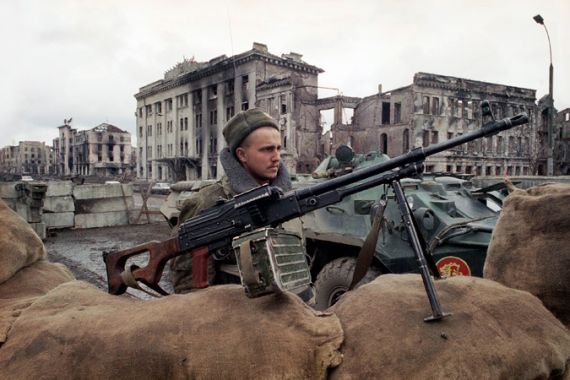
Moscow, Russia – Twenty years ago on Thursday, Moscow started what it thought would be a “blitzkrieg” against secular separatists in Chechnya, a tiny, oil-rich province in Russia’s North Caucasus region that had declared its independence.
But the first Chechen war became Russia’s Vietnam; the second war was declared a victory only in 2009. The two conflicts have reshaped Russia, Chechnya, their rulers – and those who oppose them.
In 1994, s hortly after Moscow invaded Chechnya in an effort to restore its territorial integrity, Akhmad Kadyrov, a bearded, barrel-chested Muslim scholar turned guerrilla commander, declared jihad on all Russians and said each Chechen should kill at least 150 of them.
That was the proportion of the populations on each side of the conflict: some 150 million Russians and less than a million Chechens in a small, landlocked province, which the separatists wanted to carve out of Russia.
Western media and politicians dubbed the Chechens “freedom fighters” – an army of Davids fighting the Russian Goliath.
Moscow was lambasted internationally for disproportionate use of force and rolling back on the democratic freedoms that former leader Boris Yeltsin was so eager to introduce after the 1991 Soviet Union collapse.
Tens of thousands died amid atrocities committed by both sides – and many more were displaced before 1996, when the Russians retreated, leaving Chechnya essentially independent.
Retreating was a humiliation for Russia’s military machine that less than a decade earlier had presented a seemingly formidable threat to the entire Western world.
Chechen against Chechen
Independence did not quite work out for the Chechens. The separatist government based in the ruined capital, Grozny, lost control over the rest of Chechnya.
Feuding field commanders and foreign jihadists, such as the Saudi known as Emir al-Khattab, ruled small districts with their own little armies. Kidnappings for ransom – along with primitive extraction of oil – were their main sources of income.
Many of the foreigners adhered to a puritanical Muslim ideology known as Wahhabism that ran counter to Chechnya’s Sufi traditions.
Akhmad Kadyrov, who was appointed as top Mufti of Chechnya, came into opposition with the puritans and their Chechen supporters, because he saw their extremist views as a threat to the separatist movement. In 1998, Kadyrov openly renounced the Wahhabis – and barely survived the first of many assassination attempts.
Kadyrov soon switched alliances, siding with the people upon whom he had once declared war – the Russians.
A virtually unknown ex-KBG officer, Vladimir Putin became Russia’s new prime minister i n August 1999 and w ithin weeks led a military operation against the Chechen fighters.
RELATED: Timeline: Attacks in Russia
When a series of explosions in apartment buildings in Moscow and two Russian towns killed more than 300 Russians, Moscow blamed Chechen rebels and embarked on an epic “anti-terrorist operation,” which became the second Chechen war.
Putin’s approval ratings skyrocketed, paving the way for his first presidency. A ided by Kadyrov and other Chechen clans who had pledged allegiance to the Kremlin, t he Russian military quickly returned most of Chechnya to Moscow’s control. In 2003, Kadyrov was elected Chechen president.
Russian targets
Cornered in Chechnya, the separatists took the war to Russia.
Attacks throughout the country became a grim reality of the new war and involved explosions in cities and towns, on planes and public transport.
At least two dozen attacks were carried out by female suicide bombers. Dubbed “black widows”, they became a sinister image imprinted on Russia’s collective psyche.
One such attack killed Akhmad Kadyrov in May 2004. His son, 27-year-old Ramzan Kadyrov, was too young to run for president at the time, but as head of his father’s security service, he quickly became Chechnya’s de facto ruler. I n 2007, soon after he turned 30, the younger Kadyrov was elected president.
Four months after his father’s assassination, Chechen separatists seized a public school in the town of Beslan taking more than 1,000 hostages, mostly children. Almost 200 kids died when Russian forces stormed the school. The incident changed the world’s attitude towards the Chechen cause – “freedom fighters” became “Islamic insurgents” in the Western media.
Meanwhile, the media in Russia came under attack.
“The saying was that it was journalists who won the first Chechen war,” says Tatyana Lokshina, deputy director of the Moscow branch of Human Rights Watch, an international rights watchdog.
Moscow used unfavourable media coverage of the war as an excuse to curtail press freedoms. The Kremlin took over all national television networks and most major newspapers.
| [AP] |
“For years, Vladimir Putin saw the pacification of Chechnya as his main achievement,” says Stanislav Belkovsky, a Moscow-based political analyst . “In that respect, Putin has a colossal psychological dependency on Chechnya and Ramzan Kadyrov who ensured the pacification.”
The Beslan crisis also served as a pretext to tighten political screws in Russia. Putin eliminated regional gubernatorial elections, complicated participation of opposition parties in elections, and limited democratic freedoms.
The public hailed Putin for bringing stability and pacifying Chechnya. The victory revived Moscow’s imperial ambitions – at least in the area of the former Soviet Union.
Shaping today’s Russia
Moscow won the brief 2008 Russo-Georgian war over the breakaway Georgian province of South Ossetia . In March 2014, Russia took over Crimea from Ukraine and helped unleash a civil war between pro-Russian separatists and the central Ukrainian government just a month later.
Both Chechen wars became systemic factors in shaping today's Russia. Instead of peaceful development inside the country we moved to the priority of external expansion by - Stanislav Belkovsky, political analyst
“Both Chechen wars became systemic factors in shaping today’s Russia,” says Belkovsky . “Instead of peaceful development inside the country, we moved to the priority of external expansion.”
Putin declared “the counter-terrorism operation” in Chechnya over in 2009 – just when things in North Caucasus took a turn for the worse.
Dagestan and several other provinces in the region became the new hotbeds of radical Islamism. A new generation of Moscow’s foes did not want secular separation – instead they are fighting to establish a “Caucasus Emirate” that includes adjacent Russian regions with sizable Muslim populations.
At least 529 people were killed and 457 wounded in North Caucasus in 2013, according to Kavkazsky Uzel, a Russian web portal that monitors the situation in the region. The confrontation has turned into “Europe’s most active armed conflict ” , according to the International Crisis Group, a conflict-monitoring organisation.
The insurgency became self-sustaining because of a vicious circle perpetuated by corruption and brutality.
Federal forces and police trigger the violence with extra-judicial killings, arrests, kidnappings and other abuses, according to rights groups and critics. They claim young men have no other options but to join the rebels because corrupt officials blacklist their families to extort bribes.
The fighters, in turn, blackmail corrupt officials who embezzle lavish funds from Moscow. The practise involves “sending a flash card” containing a video message in which bearded men demand a “jihad tax”.
Storming Grozny again
Ramzan Kadyrov was, perhaps, the least attentive man in the crowd of about 1,100 officials in an opulent Kremlin hall on December 4 during Putin’s annual address. The stocky 38-year-old Chechen leader fidgeted in his seat and constantly checked his phone.
Just hours before the Kremlin ceremony, a dozen Islamist fighters attacked Grozny, Chechnya’s newly-rebuilt capital. Shootouts in a publishing house, an empty school, and an office building killed 11 insurgents and 14 law enforcement officers.
A day after the attack, Kadyrov said the attackers’ families should be thrown out of Chechnya, their houses destroyed. At least six houses that belonged to relatives of the Grozny attackers have been burned down by masked men, Lokshina of Human Rights Watch said.
Kadyrov’s threats were not new to Chechens. During the second Chechen war, he led paramilitary squads known as kadyrovtsy that soon gained notoriety for abducting, torturing and killing separatists and civilians suspected of aiding them, according to human rights groups and survivors.
| that soon gained notoriety for abducting, torturing and killing separatists and civilians [AFP] |
A string of his political enemies and critics, including a former bodyguard, an investigative reporter, and a human rights activist have been gunned down in Chechnya, Moscow, Austria, and Dubai.
Kadyrov denied involvement in the contract-style killings.
Over the years, Kadyrov developed a penchant for luxury – he has a private zoo, race horses, and numerous sports cars. Pop stars, Hollywood actors and sportsmen show up at concerts held on his birthday.
His portraits are seen on billboards, government buildings and schoolchildren’s lapel pins; while streets, schools, mosques and military units are named after his father and mother.
Whatever he does is breaking news on Chechen television – he is shown threatening rebels and corrupt officials, boxing with his ministers, welcoming foreign dignitaries,and bestowing money, apartments and cars upon average Chechens.
Some say Kadyrov’s lifestyle and political ways make him look like an eccentric sovereign, not a public official on the Kremlin payroll.
“Today, Chechnya is a de facto independent state,” says Belkovsky. “Although formally [Kadyrov] shows loyalty to Putin and formally Chechnya is part of Russia.”

IMAGES
VIDEO
COMMENTS
The K-Yacht Tekno Line kitchen is an adaptable multifunctional space: surfaces that multiply, worktops that expand, even with burners in use. Complete and full of accessories such as the practical integrated storage trays. All this in an elegant ambience, with high-quality materials and solutions such as the hard-wearing acrylic stone top moulded into a continuous one-piece surface.
Three-burner hob is fitted as standard in the Mobilvetta Tekno Line K Yacht 59. The side kitchen is well separated from the lounge by a partition. With a short peninsula at the front there is adequate workspace, although much of it is behind the large, round sink. There are three burners on the flush-set hob, and one of them is an induction plate.
K-YACHT TEKNO LINE. KEA I. Kea I64; Kea I86; Kea I90; K-YACHT TEKNO LINE. K-Yacht Tekno Line 64; K-Yacht Tekno Line 86; K-Yacht Tekno Line 90; Van. ADMIRAL. ADMIRAL. Admiral K 5.1; Admiral K 6.3; Admiral K 6.5; en. ... Mobilvetta has paved the way of exclusivity in motorcaravan and van with unique, elegant and at the same time sporty models ...
K-YACHT T-LINE 95. Compare. This Mobilvetta K.Yacht 95 new motorhome is built on a Fiat chassis and comes with an automatic 180bhp engine with 4 berths and 4 travelling seats. The motorhome layout offers a huge luxurious U shape rear lounge. For those that demand the ultimate space for lounging and entertaining, this is perfect for you.
The K-yacht Tekno Line rooms are characterised by uncompromising comfort. Look around, everything is beautiful, well-kept and, above all, ... Mobilvetta 10 Years Body Integrity Privilege is the program that guarantees you a 10-year guarantee against infiltration, carrying out regular maintenance at the authorised Mobilvetta network and the ...
Mobilvetta K-Yacht 80 Tekno Edition 150BHP Fiat 150BHP 2.3 2017 | Coach Built | Drop-down bed. 2017 (17 reg) | 4 berth | End lounge | 22,363 miles | Manual | 2.3L | 4 belted seats ... Mobilvetta K-Yacht 95 Tekno Line 2023 | Motorhome | Dinette conversion. 2023 (23 reg) | 4 berth | 1,881 miles | Automatic | L:7450 x W:2350 x H:2890. Trade Seller.
The Mobilvetta K-Yacht Tekno Line MH-80's front lounge includes a large, L-shaped settee, a good-sized table that slides in all directions, and a side seat. But there might be some squabbling about who has to sit on the inner of the two rear travel seats, because legroom there isn't generous.
Huw Hopkins puts a compact A-class motorhome, the Mobilvetta Tekno Line K-Yacht 59, from Marquis Leisure, to the full live-in test.For every new Camping & Ca...
The K Yacht 95 certainly makes Mobilvetta's line-up even more amenable to the UK buyer than it already was. Its rear lounge is very comfortable, and will provide more than adequate sleeping for growing children right up until they are teenagers. If you liked this… READ THESE: Review: Mobilvetta Tekno Line K Yacht 59
Candy Evans casts an eye over this luxury A-class motorhome from Mobilvetta.For every new Camping & Caravanning review of tents, caravans and motorhomes, sub...
TALIAN ELEGANCE. STANDING OUT IN STYLE. PERFECT INTERPRETER OF THE MOBILVETTA SPIRIT.Absolute pleasure of timeless elegance: K-Yacht Teknoline is the motorho...
New for 2022, the all new & award-winning Mobilvetta Tekno Line K.Yacht 59 model boasts 3 berths and 4 travelling seats, rear bathroom and all within a compact A Class length of just 5.99m. With ample storage inside & out, this is the perfect luxury touring vehicle. Read the latest on test review from The Caravan & Camping Club below.
K-Yacht Tekno Line pampers you with walls and roof covered in soft-touch fabric in the sleeping and living areas. ... Mobilvetta 10 Years Body Integrity Privilege is the program that guarantees you a 10-year guarantee against infiltration, carrying out regular maintenance at the authorised Mobilvetta network and the tests provided for the ...
From one of Italy's most prestigious motorhome builders the Mobilvetta K-Yacht 79 Tekno Line this compact A Class is packed with features and award winning design. Based on the ever popular Fiat Ducato chassis with the uprated to 4400kg. The engine is a 2.3 litre turbo diesel MultiJet giving 160bhp with the benefit of AdBlue for lower ...
A July 2023 Mobilvetta K-Yacht 80 Tekno Line, 2184 cc with 160BHP, 9 Speed Auto Gearbox. First registered 11 th July 2023, 1 owner, 2,361 miles and will come with the full manufacturer's warranty. - Awarded best A-Class under 7 metres by the Caravan and Motorhomes Club. - Enter the motorhome and the front lounge & dining area is in front of ...
2023 (23 reg) | 4 berth | End lounge | 13,788 miles | Automatic | 2.2L | 4 belted seats | L:7450 x W:2350 x H:2890. Trade Seller(7) Alan Kerr Ltd. Find Mobilvetta K-Yacht Tekno Line used motorhomes for sale on Auto Trader, today. With the best range of second hand Mobilvetta K-Yacht Tekno Line motorhomes across the UK, find the right motorhome ...
The Mobilvetta K-Yacht Tekno Line based on the 2.3 Fiat Ducato Chassis (Euro 6) comes with 150 BHP upgrade with a manual 6 speed transmission. The well-appointed kitchen boasts an eye level oven/grill, 3 Burner gas Hob, Extractor fan, and a large 3 way fully automatic fridge with separate freezer. The K-YACHT TEKNO LINE comes with a Heat ...
K-Yacht Tekno Line, motorhome, the spearhead of the Tuscany house.Protagonist of the 2022 season which saw its launch on the market, the Mobilvetta motorhome confirms itself as Mobilvetta's most iconic model for 2023 and stands out for its design, technique, range and technology. The range offers 3 layouts, model 64, 6.99 m long central bed … Continued
Skip to main content. Discover. Trips
This is a developing situation and this post will be updated with new information as it becomes available. UPDATE: Joanna Paraszczuk of From Chechnya to Syria, a website that tracks Russian-speaking fighters in Syria, noted on Twitter that an aforementioned video of a Chechen militant speaking at Grozny mentions that the fighters have bayah (allegiance) to the Caucasus Emirate.
The following article on the pagan religious beliefs and practices of the Chechens and the Ingush was copied from the December 2010 edition (Vol. 8, No.3) of Interreligious Insight — "a journal of dialogue and engagement" published by the World Congress of Faiths. The article was written by Dr. Michael Berman, a teacher and writer whose publications include The Shamanic Themes in Armenian ...
K-Yacht Tekno Line. Kea I. Low Profile Flexibility, versatility and streamlined external lines: the low profile is today the motorcaravan par excellence. Krosser. Kea P. Van Van The road to exclusivity in Van is opened aboard Mobilvetta Admiral. Admiral. Privileges Mobilvetta. The privilege of experience. ...
11 Dec 2014. Moscow, Russia - Twenty years ago on Thursday, Moscow started what it thought would be a "blitzkrieg" against secular separatists in Chechnya, a tiny, oil-rich province in ...